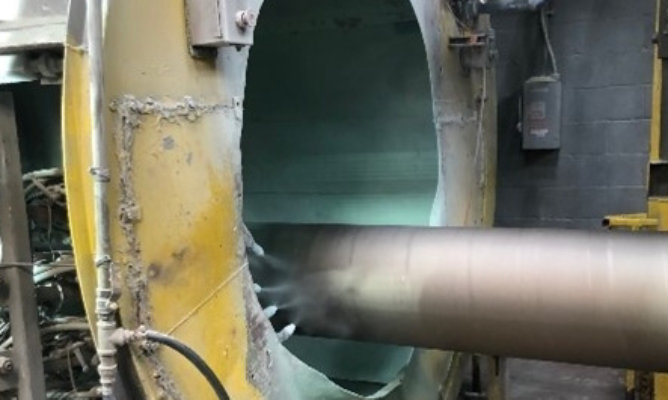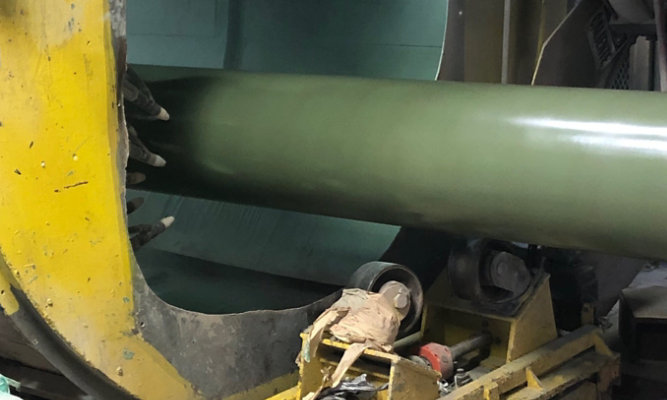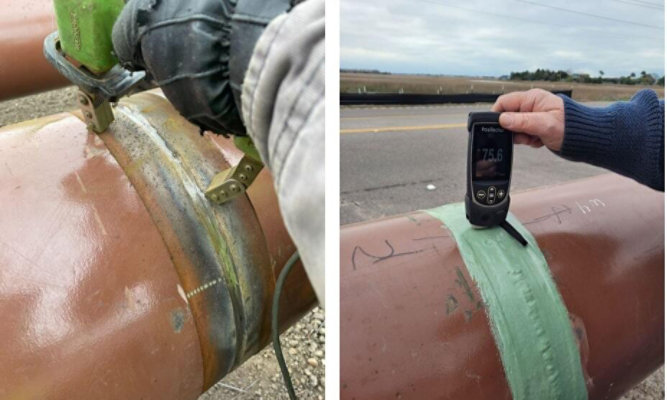Installing a New Mile-Long Steel Water Main Below a Sensitive Waterway
Addressing Environmental and Engineering Challenges in Water Transmission

The Challenge: Installing a Water Main Under a Sensitive Wetland
When the Charleston Water System set out to install a nearly mile-long water transmission line connecting its existing line on Sullivan’s Island to a nearby water main, project managers knew the task would not be without obstacles. However, the biggest challenge for the project team came in the form of the Ben Sawyer Intracoastal Waterway, which posed unique environmental and engineering challenges to laying the new pipeline in the South Carolina low country.
The installation of this critical piece of infrastructure was a collaborative effort between two public water and wastewater utilities – Charlestown Water System and Mount Pleasant Waterworks. Aimed at fortifying and adding redundancy and quality to the water network of a coastal area with a growing population, the project involved the use of horizontal directional drilling (HDD) to install a mile-long steel pipe – coated with cross-linked layers of a fusion-bonded epoxy and an abrasion-resistant overcoat – at a maximum depth of 90 feet through a tunnel bored under the sensitive habitat of marshy wetland. The project team aimed to undergo the project with the least amount of negative impact and disruptions to the community and nearby residences.
To minimize the environmental impact of the project, the team took extreme care to protect the sensitive wetland habitat and surrounding ecosystem from harm. The crews used specialized equipment to bore the tunnel and install the pipe with minimal disturbance to the surrounding environment. Additionally, the pipe was designed to withstand the more demanding HDD installation process, as well as the harsh conditions of the wetland environment, ensuring its durability and longevity.
“HDD is not a gentle process, especially on such a long pipe subject to so much pullback stress,” said James Wilson, a project engineer with Charlestown Water System. “We were looking for the maximum amount of protection against corrosion to the steel substrate, including external coatings that had to stand up to the harsh underground environment and protect the steel from corrosion.”
The installation of the new pipeline was not just essential for servicing the needs of a growing population, but also provided an emergency feed to Sullivan’s Island in the event of a break on the harbor transmission main. Moreover, it enabled the local water utilities to meter water flow, which was critical for achieving their sustainability goals.
With this new infrastructure in place, both utilities would be better equipped to manage their water resources efficiently and ensure reliable access to clean water.
The Solution: Selecting Optimal Steel Pipe Coatings and Innovative Installation Methods
While ductile iron pipe (DIP) was deemed suitable for some aspects of the project, the majority of the pipeline – totaling 5,180 linear feet – would be an 18-inch steel water main.
Despite having a strong history with DIP, Charleston Water System had limited experience working with steel pipe as a substrate. Due to the method of installation – especially given the stresses from HDD pullback – DIP was not an option, so the utility provider opted for steel.
The project team was tasked with finding an exterior coating system for the steel pipe that could handle the harsh underground environment and protect against corrosion, as well as withstand the damage that would inevitably occur while the pipe was pulled through the nearly-mile-long hole. The coating system also had to be compatible with an impressed current cathodic protection (ICCP) system, which would be installed on the steel pipeline to enhance its corrosion resistance.
Once installed, the steel pipe had to contend with unincorporated soils beneath the marshes and swamps, which are known to cause aggressive corrosion. Fortunately, most of the pipe was laid in a deeper layer of soil known as Cooper marl, which is relatively gentle on underground infrastructure.
“We didn’t want a solution. We wanted the optimal solution,” said Alan Townsend, principal with Hussey Gay Bell, a consulting engineer in nearby Mount Pleasant, South Carolina, and with offices across the South. “We looked through the entire toolbox for coatings that would perform during the immediate installation and over the pipe’s decades of service.”
In selecting the coatings for the steel pipe, engineers faced the challenge of ensuring that the coatings could withstand the stresses of the installation process without cracking or allowing moisture to penetrate. They also had to anticipate that the coatings might sustain some damage as the pipe traveled through the bored hole. To address these issues, the team chose coatings that offered flexibility during installation and could work synergistically with the cathodic protection system. This system would provide supplemental electrical corrosion control, helping to maintain the integrity of the corrosion protection even if the coatings were damaged.
“We landed on a powder-on-powder system,” added Townsend.
MCIP Industrial Enterprises Corp., a Texas-based industrial contractor, was tasked with preparing the 40-foot sections of steel pipes for coating applications. To create an angular profile of 2.5 to 3 mils and promote coating adhesion, they used an SSPC SP-10 blast on both the inside (ID) and outside diameter (OD) of each pipe. After the blasting, the pipes were moved into the application booth for coating. To ensure efficient field welding of joints, applicators masked off hold back areas, leaving a few inches of exposed steel on both the ID and OD following coating applications.
For the exterior coating, the pipes received a near simultaneous spray of 20 mils dry film thickness (DFT) of PipeClad® 2000 FBE (Fusion-Bonded Epoxy), followed immediately by a 40-mil DFT coat of PipeClad 2040 Flex ARO (Abrasion Resistant Overcoat) for a 60-mil homogenous film (Figure 1). The project team chose this coatings system because it works synergistically with ICCP systems to enable the supplemental electrical corrosion control. The ARO coating was also chosen for its flexibility when the pipe and coatings needed to withstand temporary deformations during installation.
Although the exterior coating was undoubtedly subjected to the greatest levels of stress during installation, the Sherplate™ epoxy lining also had to endure considerable stress during the installation, with the bending and flexing of the steel pipe.
The rapid succession of the coating applications, while passing through an induction heater, helped to create a stronger interlocking bond between the two layers (Figure 2). The dual-layer powder system rapidly cured, enabling high throughput for the shop while adhering extremely robust protective coatings to the outside of pipes to stave off moisture penetration and corrosion and prevent damage throughout storage, transit, construction and service.
To coat the interior of the pipes, MCIP used Sherplate PW liquid epoxy, a 100% solids epoxy that met the minimum 25-mil DFT requirements in a single pass, using automated sprayers. The coating provided superior protection and was engineered for immersion service in potable water pipes and storage tanks, meeting both ANSI/AWWA C210-15 and updated NSF/ANSI/CAN 61 standards. Applicators performed quality control measures, including holiday testing (Figure 3), on the interior and exterior of the pipes before delivery to the construction site.
The Approach: Horizontal Directional Drilling and Sectional Pipe Installation
To protect the wetland environment and its inhabitants, the project team had to find innovative ways to install the new infrastructure. Heavy equipment was not an option, so the use of HDD was necessary to pull the pre-assembled pipe through the protected area. The installation contractor, Quality Enterprises USA, Inc., completed the work with engineering oversight provided by Hussey Gay Bell.
To avoid disruption to the wetland, the nearly mile-long water main was staged and welded – four sections at a time, which were then welded to longer segments of the main pipe – along a municipal road, before being placed underground. The crew prepared the surface of the exterior hold back areas on the pipe ends before creating exterior girth welds (Figure 4) on eight to ten pipe sections at a time. They also completed magnetic particle testing and radiographic testing before manually applying coatings over the welds.
Applicators used PipeClad 5000 liquid epoxy to apply 60 mils DFT to the exterior girth welds. This quick-drying, two-component, ultra-high solids, amine-cured epoxy is engineered for long-term corrosion resistance and high-impact, abrasion and temperature resistance for below-grade underground utilities and infrastructure.
To clean the interior welds and hold back areas of dust and weld spatter, applicators used a remote blast head with media. The interior girth welds then received 25 mils DFT of Sherplate PW liquid epoxy, which applicators sprayed remotely on three to four joints at a time. Sherplate PW offers a proven user-friendly, one-pass solution for high-quality finishes.
The entire pipe was tested and documented prior to pullback using mil tests, spark tests and internal camera inspections. Steel casing pipe sections were used to keep the hole from collapsing while drilling through wet soil. The pipe was then pulled through the hole (Figure 5), and hydraulically pressure tested after pullback.
“Any damage to the welds or the coating that would cause leakage would certainly be found during that last pressure test,” said Wilson. “It’s a harsh environment for coatings, which stood up to scouring and other stresses. A tough exterior coating lets you get pipe through without half of the coating coming off.”
The Results: Reliable Water Supply and Minimal Environmental Impact
Once the pipeline was in place, the project team turned its attention to connecting the new line to the Charleston Water System on Sullivan’s Island. The team also installed a meter vault and control panel to ensure the pipeline could operate efficiently and effectively. The $8.5 million 10-month project was completed on budget and on time – with its difficult nature and successful outcome helping the team earn runner-up status for the 2022 Sherwin-Williams Impact Award program, which recognizes challenging water and wastewater projects that use high-performance coatings.
After the pipeline was installed and the infrastructure was in place, the team also made sure to undertake an extensive site restoration effort. This included adding new landscaping and streetscape features to further enhance pedestrian- and bike-friendly areas near the picturesque waterway. (Figure 6).
“The construction site was restored to look good as new,” said Wilson, “With efforts to minimize the impact on the surrounding environment, you would not even know we were there – or that there are millions of gallons of water flowing below.”
ABOUT THE AUTHOR
Gino Sincovich is Key Account Manager – Water Transmission for Sherwin-Williams Protective & Marine. During his 19 years in the coatings industry, Sincovich has primarily specialized in high-solids coatings and linings for water transmission, as well as other high-value infrastructure applications. He holds several NACE International certifications and is active on several NACE and American Water Works Association (AWWA) subcommittees. Contact: Gino.Sincovich@sherwin.com
Our Water & Wastewater Expertise
Explore our industry solutions and technology to help protect your assets.
LEARN MOREProduct Lookup
Find out more about our innovative coatings for a variety of industries.
FIND A PRODUCT




